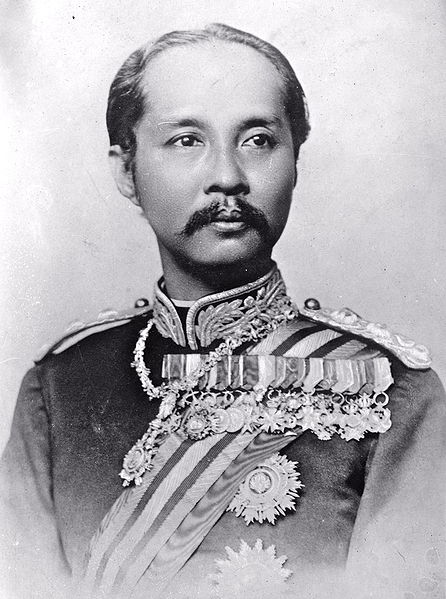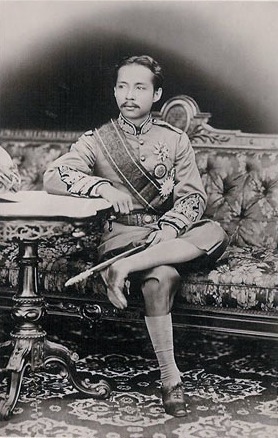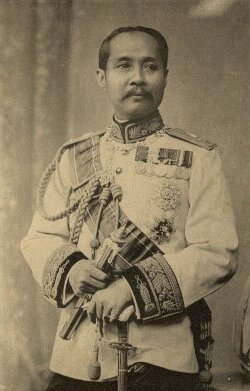<Back to Index>
- Chemist Sir James Dewar, 1842
- Architect Giacomo Quarenghi, 1744
- King of Siam Rama V, 1853



Phra Bat Somdet Phra Poramintharamaha Chulalongkorn Phra Chunla Chom Klao Chao Yu Hua, or Rama V (20 September 1853 – 23 October 1910) was the fifth monarch of Siam under the House of Chakri. He was known to the Siamese of his time as Phra Phuttha Chao Luang (พระพุทธเจ้าหลวง - The Royal Buddha). He is considered one of the greatest kings of Siam. His reign was characterized by the modernization of Siam, immense government and social reforms, and territorial cessions to the British Empire and French Indochina. As Siam was threatened by Western expansionism, Chulalongkorn, through his policies and acts, managed to save Siam from being colonized. All his reforms were dedicated to Siam’s insurance of survival in the midst of Western colonialism, so that Chulalongkorn earned the epithet Phra Piya Maharat (พระปิยมหาราช - The Great Beloved King).
Chulalongkorn was born on September 20, 1853 to King Mongkut and Queen Debsirindra. He was given his name Prince Chulalongkorn. In 1861, he was entitled Krommameun Pikanesuarn Surasangkat. His father gave him a broad education, including instruction from European tutors such as Anna Leonowens. In 1866, he became a sangha (monk) in Wat Bawonniwet according to the royal tradition. Upon his return to his secularity in 1867, he was rewarded his title as Krommakhun Pinit Prachanat. In 1867, King Mongkut became ill after his visit to Wakor for the solar eclipse observation. On his deathbed, King Mongkut wrote “My brother, my son, my grandson, whoever you all the senior officials think will be able to save our country will succeed my throne, choose at your own will.” So the diet was held to select a prince to be crowned, and Prince Chulalongkorn was chosen. As the prince was only 15 years old, Chao Phraya Si Suriyawongse was appointed the regent. The coronation was held on November 11, 1868. Si Suriyawongse then arranged the title of Front Palace of King Pinklao (who was his uncle) to be succeeded by King Pinklao’s son, Prince Yingyot (who was then Chulalongkorn’s cousin).
The young Chulalongkorn was an enthusiastic king craving for reforms. He visited Singapore and Java in 1870 and British India during
1870-1872 to see the administration of British colonies. He toured the
administrative centres of Calcutta, Delhi, Bombay and back to Calcutta
in early 1872. This journey was later the source of his ideas and
methodology of the modernization of Siam. As
a regent, Si Suriyawongse wielded a great influence. Si Suriyawongse
continued the works of King Mongkut. He supervised the digging of
several important khlongs,
such as Padung Krungkasem and Damneun Saduak, and the paving of roads
such as Chareon Krung and Silom. He was also the patron of Thai
literature and performing arts. In
1873, the king became a monk again and returned. The second coronation
was held in the same year to celebrate the king’s majority. At the end of his regency, Si Suriyawonse was raised to Somdet Chao Phraya, the highest title the nobility could attain. Si Suriyawongse himself
was the most powerful noble of the 19th century. His family, Bunnag, was a powerful one of a Persian descent dominating the Siamese politics since the reign of Rama I. Chulalongkorn then married four of his half-sisters. They were all the daughters of Mongkut - Savang Vadhana, Saovabha, and Sunandha with Concubine Piam and Sukumalmarsri with Concubine Samli. In the same year, Chulalongkorn’s first reform was to establish the Auditory Office (Th:
หอรัษฎากรพิพัฒน์) – to replace the corrupted tax collectors as the only
institution that collects taxes. As the tax collectors were under the
patronage of various nobles and also provided the financial support to
the patron, this caused a great disruption among the nobility,
especially the Front Palace. Since the time of King Mongkut, the title
of Front Palace had been as powerful as the “second king”, with
one-third of national revenue devoted to it. Moreover, Prince Yingyot
of the Front Palace was known to be acquainted with many British men,
in a time when the British Empire was considered the enemy of Siam. In
1874, Chulalongkorn chartered the Council of State - as a legislative
body - and Privy Council - as his personal counsel based on the British privy council. The members of the councils were, of course, appointed by the monarch. In
1874, the Grand Palace was bombed and a fire raged through it. The
Front Palace gave no help in extinguishing the fire. This raised
suspicions. Prince Yingyot hid himself in the British consulate so that
Chulalongkorn could do him no harm. However, the king was waiting,
ready to strike, and the tensions continued, until the retired Si
Suriyawongse returned from Ratchaburi to calm the conflicts. The
“Front Palace Crisis” incident indicated how much power was wielded by
the aristocrats and royal relatives, leaving the king little power.
This would become one of his main motives to reform the feudal Siam
politics, reducing the power held by the nobility. When
Prince Yingyot died in 1885, Chulalongkorn took that opportunity to
abolish the titular Front Palace and created the title of “Crown Prince of Siam” in accordance with the Western style. Chulalongkorn’s son, Prince Vajirunhis,
was appointed the first Crown Prince of Siam, though he never reigned.
In 1895, the Prince died of typhoid at age 17, he was succeeded by his
half-brother Vajiravudh, who was then at boarding school in England. After that, Sri Suriyawongse withdrew from politics, as did the Bunnak family.
In the northern Laotian lands bordering China, the insurgents of the Taiping rebellion had taken refuge since the reign of King Mongkut. These Chinese were called The Heos and
became bandits pillaging the villages. In 1875, Chulalongkorn sent
troops from Bangkok to crush the Heos as they ravaged as far as Vientiane. However, they met strong Chinese resistance and retreated to Isan in
1885. New, modernized forces were sent again and were divided into two
groups approaching the Heos from Chiang Kam and Pichai. The Heos
scattered and some fled to Vietnam. The Siamese armies proceeded to eliminate the remaining Heos. The city of Nong Khai maintains memorials for the Siamese dead. Freed from the Front Palace and Chinese rebellions, Chulalongkorn initiated his reforms. He established the Royal Military Academy in
1887 to train the troops in Western fashion. The modernized forces
provided the king with much more power to centralize the country. The government of Siam had remained rather unchanged since the fifteenth century. The central government was headed by the Samuha Nayak (i.e. Prime Minister), who controlled the northern parts of Siam, and the Samuha Kalahom (i.e. Grand Commander), who controlled the southern Siam in both civil and military affairs. The Samuha Nayak presided over the Chatu Sadombh (i.e.
Four Pillars). The responsibilities of each pillar were rather
overlapping and uncertain. In 1888, Chulalongkorn tried the new
ministerial government. The ministers were, in the beginning, the
members of royal family. The official establishment of ministries was
promulgated in 1892, with all ministries in equal status. As
the Council of State proved unable to veto the legal drafts or to give
Chulalongkorn advices because the members still respected Chulalongkorn
as an absolutist monarch. Chulalongkorn then dissolved the Council
altogether and transferred the duty to give advices to the cabinet in
1894. Chulalongkorn
also abolished the traditional Nakorn Bala methods of tortures in
judiciary process, which was seen as inhumane and barbaric by Western
and Modern views, and introduced the Western code. His Belgian advisor, Rolin-Jaequemyns, played a great role in the development of modern Siamese law and judicial system. Chulalongkorn
was the first Siamese king to send the royal princes to Europe to be
educated. In nineteenth century Europe, nationalism flourished and
there was a call for liberty. The princes, of course, had been
influenced by the liberal ideas of democracy and elections. They encountered republics like France and constitutional monarchies like the United Kingdom. In 1884 (103 of Rattakosin Era), Siamese officials in London and Paris arranged a request to Chulalongkorn, citing the threats from European colonialism were coming and Siam should be reformed like Meiji Japan and
Siam should became a constitutional monarchy. However, Chulalongkorn
stated that it was not yet time and he himself was urging reforms. Throughout
Chulalongkorn's reign, writers with radical ideas had their works
published for the first time. The most notable ones included Tianwan, who had been imprisoned for 17 years and from prison he produced many works criticizing the old Siamese society. In 1863, King Norodom of
Cambodia was forced to put his own country under the French
Protectorate. The cession of Cambodia was officially formulated in
1867. However, Inner Cambodia (as called in Siam) consisting of Battambang, Siemreap,
and Srisopon, remained a Siamese possession. This is the first
territorial cession, which would be followed by many. In 1887, French
Indochina was formed composed of Vietnam and Cambodia. In 1888, French troops invaded Northern Laos to subjugate the Heo insurgents. However, they then never left. Yet the French demanded more Laotian lands. In 1893 Auguste Pavie, the French vice-consul of Luang Prabang, requested the cession of all Laotian lands east of Mekong. Siam, of course, resented the demand, leading to the Franco-Siamese War of 1893. The French gunboat Le Lutin entered the Chao Phraya and anchored near the French consulate ready to attack. Fighting was observed in Laos. Inconstant and Comete was
attacked in Chao Phraya, and the French sent an ultimatum, an indemnity
of three million francs; the cession and withdrawal from Laos. Siam did
not accept the ultimatum. French troops then blockaded the Gulf of Siam
and occupied Chantaburi and Trat.
Chulalongkorn sent Rolin-Jacquemyns to negotiate. The issue was
eventually settled with the cession of Laos in 1893, but the French
troops in Chantaburi and Trat refused to leave. The cession of Laotian
vast lands had a major impact on Chulalongkorn’s spirit. Prince Vajirunhis died in 1894. Prince Vajiravudh was created crown prince to replace him. Chulalongkorn then realised the importance of maintaining the navy. He established the Royal Thai Naval Academy in 1898. In
spite of Siamese concessions, French armies continued the occupation of
Chantaburi and Trat for another 10 years. An agreement was reached in
1903 that French troops would leave Chantaburi but hold the coastland
from Trat to Koh Kong. In 1906, the final agreement was reached. Trat
was returned to Siam but the French kept Koh Kong and received Inner Cambodia. Upon
seeing the seriousness of foreign affairs, Chulalongkorn made his visit
to Europe in 1897; he was the first Siamese monarch to do this and to
gain European recognition of Siam as a fully independent and honorary
power. He appointed his queen, Saovabha, as regent in Siam during his
travel to Europe. Siam had composed of the network of cities according to the Mandala system with local rulers owing tribute to Bangkok.
Each city retained quite a substantial degree of autonomy, as Siam
wasn’t a “state” but a “network” of city-states. With the rise of
European colonialism, the Western concept of state and territorial
division was introduced. It had to define explicitly which lands were
“Siamese” and which lands were “foreign”. The conflict with the French
in 1893 was an example. With his experiences during the travel to British colonies and the suggestion of Prince Damrong, Chulalongkorn instigated the hierarchical system of Monthons in 1897, composing of Province, City, Amphoe, Tambon, and Mhu Ban (village)
in the descending order. (Though a whole monthon - the Eastern Province
- e.g. Inner Cambodia - was given off to the French in 1906) Each
monthon was overseen by an intendant of the Ministry of Interior.
This had a major impact, ending the power of all local dynasties. The
central authority now spread all over the country through the
administration of intendants. For example, the Lanna states in the
north (including the Kingdom of Chiangmai,
Principalities of Lampang, Lampoon, Nan, and Prae) owing tributaries to
Bangkok, were made into two monthons, neglecting the existence of the
Lanna kings. The
construction of railways in Siam was on the political basis. It was
necessary to connect all the country to have an eye on every part of
Siam. In 1901, the first railway was opened from Bangkok to Korat. In
the same year, the first power plant of Siam gave off its energy.
Electric lights were turned on along the roads. The local rulers did not give up, as three rebellions sprang up in 1901 - the Ngeaw rebellion in Prae, the Phi Buns in Isan, and the Rebellion of Seven Sultans in the south. All these insurgents were crashed in 1902 with the city rulers were stripped off their power and imprisoned. Siamese
authorities had exercised a substantial control over Malay sultanates
since Ayutthaya times. The sultans sought British support to
counterweight Siamese influence. In 1909, the Anglo-Siamese Treaty of 1909 was formulated. Four sultanates (namely Kedah, Kelantan, Terengganu, and Perlis) were brought under British influence in exchange for Siamese legal rights and a loan to construct railways in southern Siam. Since the time of Ayutthaya the lives of Siamese commoners and slaves had been closely regulated by the government. All Siamese common men called prai (ไพร่) were subjected to the Siamese corvée system. Each man, at the time of his majority, would be registered to a krom - any kind of government organization or title given to royal members - or a nobleman. Those assigned to a krom were called prai luang (ไพร่หลวง). Each year a prai luang would
enter the service for the government for three months. The rest of the
year he would farm for himself. However, the corvée system
declined after the Bowring Treaty,
which gave rise to a new class of employed labourers out of the
regulations of the government. Moreover, many noblemen owned a large
number of prai.
As Chulalongkorn sought to undo the power of nobility, more effective
control of manpower was needed. After the establishment of a provincial
system, Chulalongkorn began the census to get the statistics of all men available to the government. In 1900, the Employment Act stated that all workers should be paid, not forced to do their work, and in 1905 the Conscription Act established military conscription in Siam, thus ending the traditional corvée system. Chulalongkorn was best known for his abolition of Siamese slavery. He associated the abolition of slavery in the United States with the bloodshed of the American Civil War.
Chulalongkorn, to prevent such a bloodbath in Siam, provided several
steps towards the abolition of slavery, not an extreme turning point
from servitude to total freedom. Those who found themselves unable to
live on their own sold themselves into slavery by rich noblemen.
Likewise, when a debt was defaulted, the borrower would become a slave
of the lender. If the debt was redeemed, the slave regained freedom. However,
those whose parents were household slaves (ทาสในเรือนเบี้ย), were bound
to be slaves forever because their redemption price was extremely high. Because
of economic conditions, people sold themselves into slavery in great
numbers and in turn they produced a large number of household slaves.
In 1867 they accounted for one-third of Siamese population. In 1874,
Chulalongkorn enacted a law that lowered the redemption price of
household slaves born in 1867 (his ascension year) and freed all of
them when they had reached 21. The
newly freed slaves would have time to settle themselves as farmers or
merchants so they would not become unemployed. In 1905, the Slave Abolition Act ended
Siamese slavery in all forms. The reverse of 100-baht notes in
circulation since 2005 depict Chulalongkorn in navy uniform abolishing
the slave tradition. The Royal Equestrian Statue of
Chulalongkorn was finished in 1908 to celebrate the 40th anniversary of
the king’s reign. It was cast in bronze by a Parisian metallurgist, and
then placed on the marble base. Chulalongkorn
had visited Europe two times in 1897 and 1907; the latter time was to
cure his kidney disease. His last accomplishment was the establishment
of a plumbing system in 1908. He died on 23 October 1910 of his kidney
disease in Dusit Palace, and succeeded by his son Vajiravudh. Chulalongkorn University, founded in 1917 as the first university in Thailand, was named in his honour. In 1997 a memorial pavilion was raised in honor of King Chulalongkorn in Ragunda, Sweden. This was done to commemorate King Chulalongkorn's visit to Sweden in 1897 where he visited the World Fair. During the time when Swedish-Norwegian king Oscar II travelled to Norway for a council, Chulalongkorn went up north to study forestry. Beginning in Härnösand and travelling via Sollefteå and Ragunda he mounted a boat in the small village of Utanede in order to take him back through Sundsvall to Stockholm.
His passage through Utanede left a mark on the village as one street
was named after the king. The pavilion is erected right next to that
road. In 2003, the Thai baht 100-baht note was revised to depict King Chulalongkorn in navy uniform and, in the background, abolishing the slave tradition.